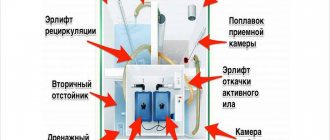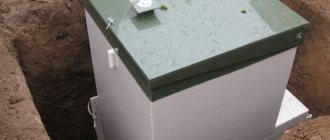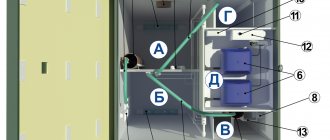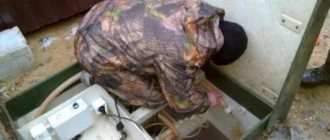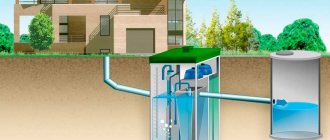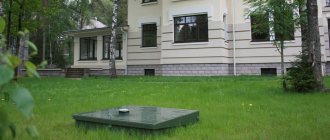Topas - introduction to the septic tank
This equipment, which has a lot of positive feedback from users, is characterized by a simple design. The Topas septic tank consists of several chambers - a receiving compartment, an aeration tank, a secondary settling tank, and a box for wastewater treatment. The principle of its operation is elementary. It is based on natural processes for effective sewage treatment. As a result of the operation of such a system, process water comes out of the septic tank. The degree of its purification in most cases reaches 97–98%.
Septic tank "Topas"
The station we are considering is made in the form of a fairly large container made of durable plastic, which is divided into several parts using partitions. In each of the above sections of the septic tank, aerobic microorganisms decompose organic compounds entering the autonomous sewer system. Topas is equipped with a system for efficiently pumping wastewater from one chamber to another, as well as special compressors. The latter are necessary for pumping air into the septic tank. Due to this, the temperature in the autonomous sewer system is always maintained at an optimal temperature for the normal functioning of bacteria. Microorganisms are also constantly supplied with nutrients and oxygen.
Experts call Topas stations almost an ideal option for providing high-quality sewerage to country houses. But even such a highly efficient design requires regular and proper maintenance. If it is carried out within the specified time frame and taking into account the recommendations of the septic tank manufacturer, Topas works for many years and decades without breakdowns.
How to use the Topas septic tank in winter?
This device is designed in such a way that it can function with equal efficiency in both warm and cold seasons. "Topas" can work with wastewater that has a low temperature.
The cover of the treatment station is equipped with heat-insulating mechanisms. Therefore, if it is -20°C outside the window and at least 1/5 of the household wastewater enters the treatment system, you do not need to worry about the operation of your device and carry out preventive maintenance. However, if the temperature drop was sharp and the frost promises to last a long time, it is recommended to provide additional insulation to the upper part of the device. But remember about the ventilation system, the air intake of which is located in the lid of the septic tank and which should not be blocked.
In addition, manufacturers warn users against opening technological hatches at temperatures below -15°C.
Be sure to keep a record of your care for the Topas WWTP. Reflect in it all the service and repair work that you carry out. Follow the standards for seasonal operation of the septic tank, which are listed above. Responsibility for the breakdown of the WWTP due to a violation of the maintenance algorithm falls on the shoulders of the user, not the manufacturer.
Cleaning station maintenance – frequency and required actions
Operation of Topas provides for daily visual monitoring of the functioning of the system. To inspect simple septic tanks under the brand we are interested in, we need to remove a special mug and inspect the equipment components. If the station is equipped with light signaling equipment, there is no need for a personal inspection of the station. The automation itself will signal about malfunctions.
Once a week you need to visually monitor the quality of wastewater treatment in the septic tank. And every three months the secondary settling tank is cleaned using improvised means or special pumping equipment (mamut pump). If the productivity of Topas is more than 4 cubic meters of waste per day, you can call a sewer truck once a quarter. In cases where the station processes up to 3 cubic meters of contaminated water per day, you just need to clean the walls of the sump with an ordinary broom. This is quite enough, since almost all the sludge in small systems independently leaves the stabilizer via airlift.
Septic tank wastewater treatment
Every six months, you should carefully inspect the secondary settling tank, filtration system, airlift and Topas hair trap. If you see that the sludge has not been removed from the stabilizer, be sure to connect the drainage pump and clean the autonomous sewer system. After 2–4 years of operation, it is recommended to perform the following actions:
- Inspect all screw and bolt connections in the system. You simply need to tighten loose fasteners or replace rusted hardware.
- Check the functionality of the membrane installed on the compressor of the station. Professionals advise changing this element every 4 years. But if you see that the membrane copes with its tasks, replacing it within the specified time frame is optional.
Once every five years, the septic tank is thoroughly cleaned. It involves removing accumulated mineralized sludge from the aeration tank and equalization tank. And every 10 years it is advisable to install new aeration elements into the system. This procedure must be done even in cases where the autonomous sewage system is used quite rarely - only in the summer or exclusively on weekends.
How to understand that a Topas septic tank requires maintenance?
To determine whether it is time to clean the Topas septic tank and how much sludge needs to be pumped out, you need to take a sample of the drainage from the aeration tank chamber. To do this, you will need a liter glass jar and a small transparent bucket on a rope; a plastic cup will also do. The sample must be taken while the aerator is running in the chamber, mixing the effluent. Place a bucket in the aeration tank, scoop it up and pour the sample into a glass jar. Afterwards, you will need to let the drain settle for 30-40 minutes. If after this time you see that the sludge in the jar occupies 50% of the space or more, then the installation definitely requires maintenance.
Regular cleaning of the septic tank - how to do it yourself?
Every 3–6 months, waste sludge can be removed from the stabilizer using a mamut pump built into the system, or through a drainage apparatus. In the first case, the work flow diagram is as follows:
- Turn off the septic tank.
- Remove the mamut pump from the special clip and take it outside the system.
- Slightly loosen the metal clamp located at the end of the hose in order to easily remove the plug from the pump.
- Raise the switch (float) in the receiving compartment. To do this, you need to run the system in forward phase mode.
- Pump about half the volume of the chamber into a pre-prepared reservoir.
- Turn off the septic tank, install the plug in place and secure the hose in the old place. Add clean water to the chamber. Cleaning complete!
Removing debris from a septic tank with a mamut pump
When using a drainage device, cleaning is carried out according to a similar algorithm. But in this case, you need to place one end of the hose in a compost pit or some container, and lower the other to the bottom of the sludge compartment.
After cleaning the equipment with the pump is completed, you should rinse the walls of the stabilizer chamber and fill it with water to the standard level. Wall washing is usually performed with special equipment operating under high pressure. Such devices are called mini-washes. As noted earlier, in case of minor contamination of the stabilizing compartment, it is possible to remove sludge from its internal surfaces using a broom.
Flooding of the station.
This is the most expensive and unpleasant malfunction. Before testing, be sure to remove and disassemble the air pumps and dry them in this condition for at least a day. Do not turn on! Dry the entire electrical part of the station.
Reasons (there are possible options for gravity and forced models).
FOR FORCED ONLY:
a) malfunction in the drainage pump - remove the pump and check in a separate outlet, raise and lower the float switch. Possible malfunction:
- “sticking” of the switch; if the pump does not come to life, replace it; if it works, replace it, making sure that the float switch has free movement in the drainage tank.
FOR GRAVITY AND FORCED:
b) malfunction of the air lift of the main pump - check whether liquid is being pumped from the receiving chamber to the aeration tank. Possible malfunctions:
- The air lift of the main pump is clogged - clean it;
- the airlift jet of the main pump is clogged - clean or replace;
- The main pump air lift air tube is torn - replace;
- the membrane of the compressor supplying air to the airlift of the main pump is torn - replace the membrane, it cannot be repaired;
- The float switch (working sensor) in the receiving chamber of the station is faulty - replace it;
c) the drainage channel for purified water from the septic tank is clogged or frozen (in winter). This occurs when the outlet route is installed incorrectly.
List of maintenance services for the Topas septic tank
The efficiency of the Topas septic tank is directly determined by the quality of service. The standard list of works includes:
- Primary diagnosis. An external inspection and assessment of the quality of the unit’s operation allows us to promptly identify possible faults and draw up a work plan for the maintenance of the septic tank.
- Removing dense sediment from the receiver. When using VOC “Tver”, insoluble fractions accumulate at the bottom of the primary block. The sediment should be periodically removed with a special pump or a sewer truck until the compartment is completely empty.
- Pumping out activated sludge. The Topas treatment plant operates effectively with an optimal amount of active bacteria. To maintain the normal volume of biomass, sludge should be pumped from the aeration tank chamber into the receiver using airlifts or disposed of with a fecal pump or a sewer truck.
- Cleaning brushes. During maintenance, the brush attachments should be washed under high pressure water, and the load should be renewed once every 15 years.
- Cleaning the walls of the chambers. Plaque on the walls appears when the septic tank maintenance schedule is not met.
- Cleaning compressor air filters.
- Backfilling with crushed limestone.
After maintenance, Topas is checked for adjusted air supply, according to the data sheet. When the first tank is emptied, the sludge from subsequent chambers is pumped into a receiver for further disposal.
Cleaning - what products will be needed for this?
It is possible to ensure the effective operation of a wastewater treatment plant only with its proper operation and periodic implementation of treatment measures. To protect it from blockages, you should wash the pipes with boiling water at least once a week. For example, one kettle of hot water will be enough to flush out oil, grease and other deposits that accumulate in the sewer line. If this septic tank maintenance procedure is performed regularly, then no more complex cleaning work will be required.
Watch the video and do the cleaning:
You can use chemicals only if you are completely confident in the best results. But they must be selected in such a way that damage does not occur in the device itself. When cleaning a Topas septic tank with your own hands, it is better to use products with natural ingredients, for example, a mixture of baking soda and vinegar, and rinsing the system with hot water.
Moreover, the effect of these drugs is accompanied by a chemical reaction, the progress of which can be heard. This cleaning results in the breakdown and subsequent removal of dirt and is used as a seasonal maintenance 2-3 times a year.
Stages of maintenance of a septic tank model Topas
Cleaning should not only be carried out regularly, but also include a list of works performed in a certain order. The first thing you need to do before starting to service the equipment is to disconnect the device from the power supply and wait until the sludge settles in the stabilizer.
Maintenance in winter:
Next, the Topas septic tank is cleaned with your own hands. To do this, a pump is lowered to the bottom of the stabilizer compartment. The hose from it is led into a drain ditch or any other place into which the contents of the tank are supposed to be pumped out.
Then the pump is started and only part of the volume of activated sludge is drained, not exceeding half, since the system will not be able to work without it. The next stage of maintenance work is to fill the compartment with clean water and start the cleaning device.
If you plan to clean the septic tank filter, then you will also have to first disconnect the equipment from the power supply. Next, the airlift hoses are disconnected from the injectors. Moreover, in the future, when connecting them, the existing order must be observed, since if the connection is incorrect, the operation of the system will be impossible.
Airlifts disconnected from their mountings are removed from the tank and all their components are washed using a high-pressure apparatus. In the same way, large fraction filters are removed from the septic tank and cleaned using the same equipment.
Next, work is carried out to install the seized equipment and turn on the septic tank.
Another element that requires regular cleaning is the non-degradable particle collection device. It is also removed from the septic tank chamber, washed and returned back, followed by startup of the equipment.
All of the above maintenance work on the Topas septic tank can be performed either by specialists or independently.
Conclusion
Typically, owners entrust the first maintenance of a new treatment system to specialists. But, having made sure that such work does not require specific knowledge and skills, they then try to carry it out without the participation of paid employees.
Important! During the maintenance process, clearly follow the sequence of actions in the process of cleaning the Topas septic tank so that problems do not arise in the further operation of the system.
Related posts:
- Which septic tank cover to choose?
- How good is the Septic Biotank?
- How to correctly install a septic tank Tank
- Distinctive features of the Poplar septic tank
- What and how to choose a septic tank for a cottage and dacha
Correct operation
How often you will need to service your Topas septic tank yourself depends, among other things, on how the rules of its operation are followed.
First of all, you cannot:
- dispose of leftover vegetables and mushrooms down the drain;
- flush moldy foods down the toilet, as they can cause bacteria to die;
- prevent acids, alkalis, gasoline and other aggressive compounds from entering the septic tank;
- send inorganic waste (for example, construction waste) and non-degradable materials (polyethylene, plastic and others) to the sewer.
To prevent large particles of debris from entering the sewer system, you need to install removable screens in the drain holes of sinks and sinks. In the event of a power outage, water should be used as a last resort because when the pumps and compressors are not running, the septic tank will overflow very quickly.
Maintenance
If a Topaz septic tank is installed on the site, maintenance of the installation must be regular. These preventive measures will not take much time and can be done with your own hands. Preventive maintenance of Topas are as follows:
- clean the filter for coarse fractions once a month;
- once every three months it is necessary to clean the Topas septic tank, carried out by removing sediment from the sludge receptacle;
- once every six months, clean the device in which debris particles that cannot be processed by bacteria accumulate;
- once every two years it is necessary to carry out scheduled repairs of compressors by changing the membranes;
- Aerators need to be replaced once every 12-15 years.
Thus, maintenance of the Topas station is not a particularly difficult task; it can easily be done with your own hands. Lack of regular maintenance and cleaning are some of the most common reasons why stations require repairs.
Maintenance frequency
The Topas septic tank is fully automated, eliminating the need for daily maintenance. Planned work provided for in the technical passport includes the following frequency:
Weekly monitoring of the correct operation of components with the lid open.
Quarterly removal of excess sludge from the second settling tank. It’s easy to determine the need for a procedure! A sample of the active mixture in the sludge stabilizer should be taken and placed in a 1 liter glass container. The mixture sits for 30 minutes, activated sludge settles to the bottom of the container, and a layer of clean water forms on top. Pumping is carried out when the sludge volume reaches 50% or more.
Annual renewal of compressor membranes, cleaning of the receiver from mineral deposits. The process is easy to do with your own hands. You will need to immerse the fecal pump at the bottom of the first chamber, pump out 40% of the liquid mass, and fill the compartment with clean water to the original liquid level. Repeat the steps until the water is completely clear.
Once every 3 years, pumping out mineral sediment from the aeration tank chamber. Cleaning is also done with your own hands: a fecal pump is placed at the bottom, 40% of the liquid is pumped out, and clean water is added to the original water level. Continue until the effluent is completely clarified.
Once every 10 years, replace the aeration elements on aerators. The service should be entrusted to professionals.
Elements of the Topaz autonomous station
For long-term operation of the equipment, it is necessary to ensure the functioning of the station elements, namely anaerobic bacteria, which ensure the process of decomposition of solid waste particles, and devices for the Topas septic tank, the main of which are:
- compressor device;
- drainage pump;
- air duct valve;
- water level control sensor.
All devices included in the station must correspond to the size and type of septic tank, and their cleaning must be carried out according to instructions.
After installing the equipment, you can think about a decorated manhole, which will help brighten up the landscape without disturbing its appearance with a sewer overhang. Drain well covers can be made of plastic and look like decorative stone or installation. Such hatch covers are lightweight and will fit well into the interior of the site. In addition, they will protect the system from unwanted debris getting inside.
